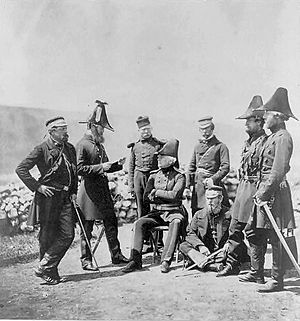George Brown (British Army officer) facts for kids
Quick facts for kids
Sir George Brown
|
|
|---|---|

Sir George Brown, photographed by Roger Fenton in the Crimea in 1855
|
|
| Born | 3 July 1790 Linkwood, Elgin, Scotland |
| Died | 27 August 1865 (aged 75) Linkwood, Elgin, Scotland |
| Allegiance | |
| Service/ |
|
| Rank | General |
| Commands held | Light Division |
| Awards | Knight Grand Cross of the Order of the Bath Knight of the Royal Guelphic Order |
General Sir George Brown (born July 3, 1790 – died August 27, 1865) was a brave British Army officer. He is best known for leading soldiers in two major wars. These were the Peninsular War and the Crimean War.
Contents
Early Life and Education
George Brown was born in a place called Linkwood, near Elgin, in Scotland. His father, also named George Brown, was an important person in Elgin. Young George went to school in Elgin.
Starting His Military Journey
George Brown joined the army in 1806. He became a lieutenant just a few months later. His first time fighting was in the Mediterranean Sea area. He also fought at Copenhagen in 1807.
Fighting in the Peninsular War
His regiment, the 43rd, was one of the first British groups to arrive in Spain. This was when the Peninsular War began. Brown fought in important battles like Vimeiro. He was also part of the difficult retreat to Corunna.
Later, in 1809, a famous group called the Light Division was formed. George Brown was part of this division. He fought in many battles between 1810 and 1811. He was badly hurt at the Battle of Talavera. After recovering, he became a captain. He then went to a special school for officers called the Staff College.
In late 1812, he returned to the war in Spain. He served under Major-General Lord Aylmer. His brave actions helped him become a major.
Service in America
After the Peninsular War, Brown's regiment went to America. They fought under General Robert Ross. Brown was seriously wounded again at the battle of Bladensburg. Because of his bravery, he was promoted to lieutenant colonel. He was only 25 years old at this time.
Years in London
After his time fighting, Sir George Brown worked in London for over 25 years. He held various important jobs in the army's headquarters. He became a colonel in 1831. By 1852, he was a lieutenant general. He also received an important award called the Knight Commander of the Order of the Bath. In 1850, he became the Adjutant-General to the Forces. This was a very high-ranking job.
Leading in the Crimean War
In 1854, British soldiers were sent to the East for the Crimean War. Sir George Brown was chosen to lead the Light Division. He was known for being very strict but also caring for his soldiers. They loved him.
At the Battle of Alma, a horse was shot from under him. At the Battle of Inkerman, he was wounded while leading French soldiers. The next year, he led British troops in an important mission against Kertch. He had to return home due to his injuries on June 29, 1855. This was the same day that Lord Raglan, the main British commander, died.
Later, Sir George Brown was promoted to the rank of General. This promotion was made official from September 7, 1855. From 1860 to 1865, he was the Commander-in-Chief in Ireland.
Awards and Recognition
Sir George Brown received many awards for his service. These included:
He passed away in 1865 at his birthplace in Linkwood.
Special Army Roles
Sir George Brown also held several special honorary roles in different army regiments:
- Colonel of the 77th (East Middlesex) Regiment of Foot (1851–1854)
- Colonel of the 7th (Derbyshire) Regiment of Foot (1854–1855)
- Colonel of the 32nd (The Cornwall) Regiment of Foot (Light Infantry) (1863–1865)
- Colonel-in-Chief of The Prince Consort's Own Rifle Brigade (1863–1865)


